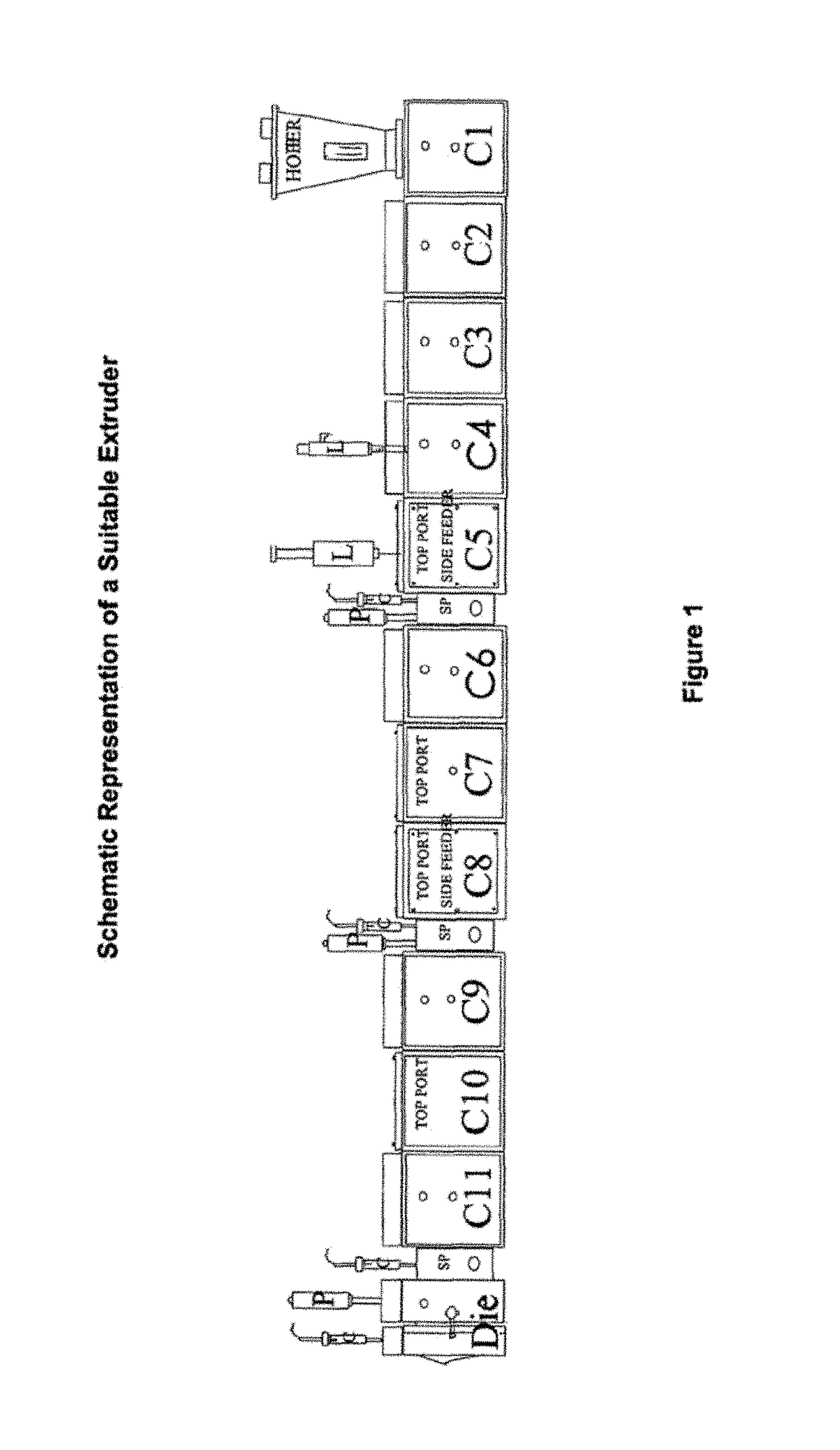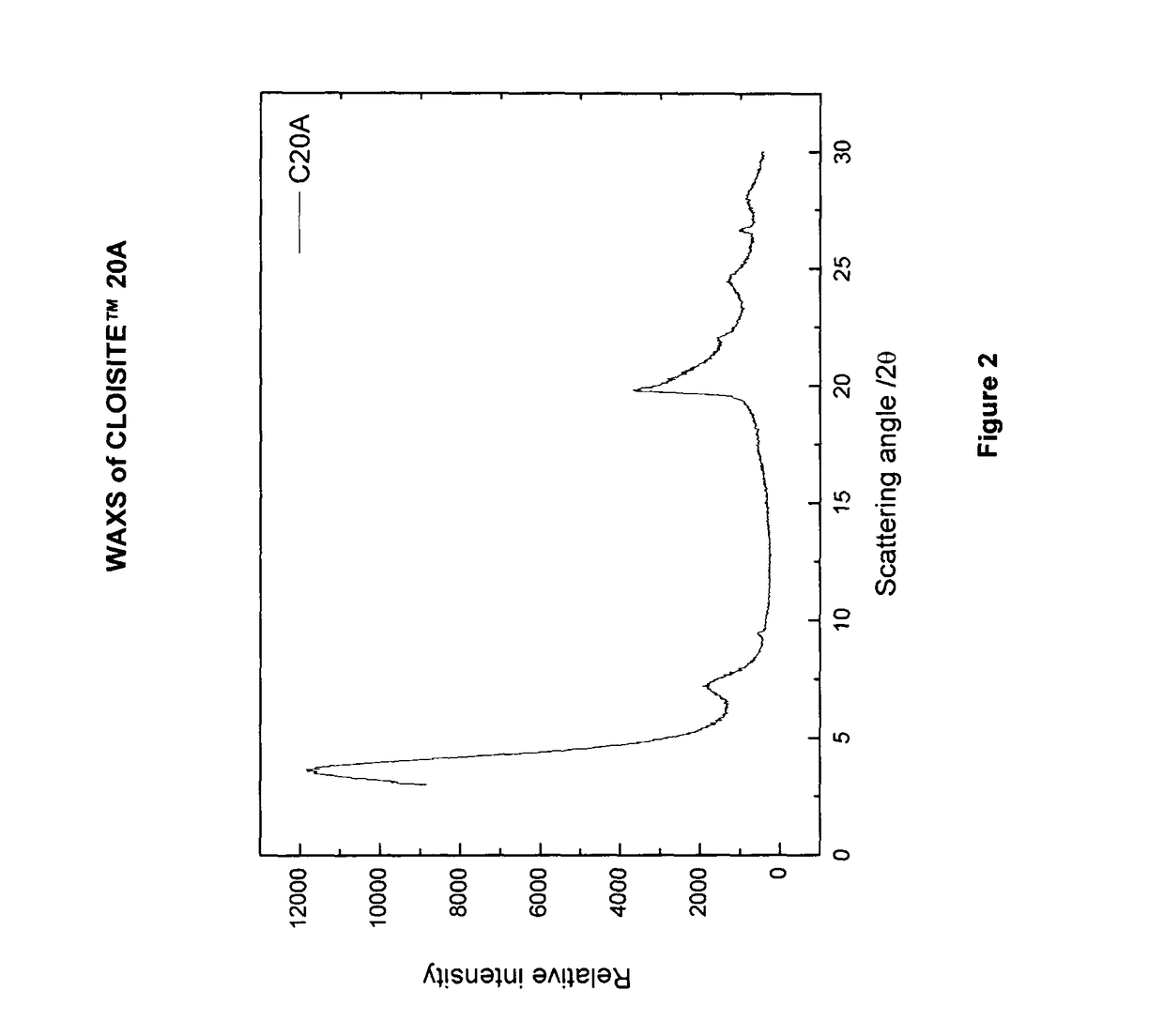Starch nanocomposite materials
a technology of nanocomposite materials and starch, which is applied in the field of nanocomposite materials, can solve problems such as partial exfoliation
- Summary
- Abstract
- Description
- Claims
- Application Information
AI Technical Summary
Benefits of technology
Problems solved by technology
Method used
Image
Examples
examples
Materials
[0073]CLOISITE™ 20A, a natural montmorillonite modified by dimethyl di(hydrogenated tallow) quaternary ammonium chloride from Southern Clay Industries
[0074]CLOISITE™ 25A, a natural montmorillonite modified by dimethyl 2-ethylhexyl (hydrogenated tallow) ammonium methylsulfate from Southern Clay Industries
[0075]CLOISITE™ 93A, a natural montmorillonite modified with methyl di(hydrogenated tallow) ammonium bisulfate from Southern Clay Industries
[0076]GELOSE™ A939, a high amylose corn starch, GELOSE™ 80, with a quoted amylose content of ˜80%, modified by reaction with propylene oxide to form 6.5% hydroxypropyl substitution (w / w). GELOSE™ A939 was obtained from Penford, Australia
[0077]ECOFILM™, high amylose corn starch, NYLON™ VII, with a quoted amylose content of ˜70%, modified by reaction with propylene oxide to give 6.5% hydroxypropyl residues (w / w). It was obtained from National Starch and Chemical Company
[0078]Poly(vinyl alcohol), ELVANOL™ from Dupont
[0079]Stearic acid, PALM...
examples 1 and 2
[0088]The examples tabulated in Table 3 demonstrate clay-starch masterbatch preparation.
[0089]The following procedure is typical:
[0090]Preparation of 10% Clay Masterbatch (CLOISITET™ 25A)
[0091]GELOSE™ A939 (16.2 kg), PVOH (1.62 kg), stearic acid (180 g) and CLOISITE™ 25A (2 kg) were combined in a tumble mixer for 2 h. The mixed powder was fed to the main feed hopper of the extruder via a gravimetric feeder through an auger at rate of 3.5 kg / h. The temperature profile was set as shown in Table 1. Water was injected into the barrel through a liquid pump at a flow rate of 26 g / min. The screw speed was 162 rpm. The extrudate strand was collected, air-dried overnight and pelletized.
[0092]
TABLE 3Preparation of the masterbatchClayGELOSE ™PVOHStearic acidExampleClay type(%)A939 (%)(%)(%)1CLOISITE ™10.0081.008.100.9025A2CLOISITE ™10.0081.008.100.9020A
examples 3 to 5
[0093]The examples tabulated in Table 4 demonstrate the preparation of starch nanocomposite sheet (2% CLOISITE™ 25A) from 10% clay masterbatch The following procedure is typical:
[0094]A starch mixture was prepared comprising GELOSE™ A939 (9 kg), PVOH (0.9 kg) stearic acid (0.1 kg) and mixed in the tumble mixer for 2 h. The dry masterbatch pellets (from Example 1 above) were hydrated (the water was added into the mixer at a flow rate of 2 mL / min) in a tumble mixer overnight to achieve a final water content of approximately 26%. The temperature profile was set as shown in Table 1 for the 2nd extrusion. The screw speed was 162 rpm. The starch mixture was fed via a gravimetric feeder to the main hopper at a rate of 2.8 kg / h. The hydrated masterbatch pellets were fed via a second gravimetric feeder to the main hopper at a rate of 700 g / h. Water was injected at a flow rate of 26 g / min. The extrudate sheet was collected, air-dried for 2 h, rolled and stored in plastic bags.
[0095]
TABLE 4Pre...
PUM
| Property | Measurement | Unit |
|---|---|---|
| w/w | aaaaa | aaaaa |
| w/w | aaaaa | aaaaa |
| time | aaaaa | aaaaa |
Abstract
Description
Claims
Application Information
 Login to View More
Login to View More - R&D
- Intellectual Property
- Life Sciences
- Materials
- Tech Scout
- Unparalleled Data Quality
- Higher Quality Content
- 60% Fewer Hallucinations
Browse by: Latest US Patents, China's latest patents, Technical Efficacy Thesaurus, Application Domain, Technology Topic, Popular Technical Reports.
© 2025 PatSnap. All rights reserved.Legal|Privacy policy|Modern Slavery Act Transparency Statement|Sitemap|About US| Contact US: help@patsnap.com



